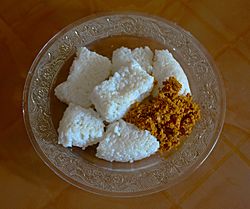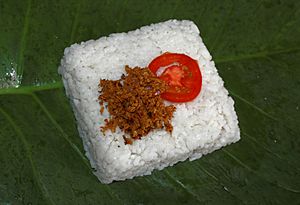Kiribath facts for kids

Kiribath
|
|
| Alternative names | කිරිබත්, Milk rice |
|---|---|
| Course | Breakfast, Main dish |
| Place of origin | Sri Lanka |
| Associated national cuisine | Sri Lankan cuisine |
| Cooking time | 50 minutes to 1 hour 20 min |
| Main ingredients | Rice, coconut milk |
| Ingredients generally used | Salt |
| Variations | Mun Kiribath, Imbul kiribath |
| Similar dishes | Coconut rice |
Kiribath (pronounced KIRI-bath) is a special and traditional food from Sri Lanka. It's a type of rice dish, often called "milk rice." People make it by cooking rice with coconut milk. This gives it a creamy texture, like a rice cake or rice pudding.
Kiribath is a very important part of Sri Lankan cuisine. It's often eaten for breakfast, especially on the first day of each month. It also marks important moments or new beginnings in life. It is one of the most famous traditional dishes in Sri Lanka.
Contents
What Does Kiribath Mean?
The name Kiribath comes from two words in the Sinhala language. Kiri (කිරි) means "milk." Bath (බත්) means "rice." So, Kiribath simply means "milk rice."
History of Kiribath

The exact start of Kiribath is not fully clear. However, this special dish seems to be unique to Sri Lanka.
One story says that a woman named Sujata offered Kiribath to Gautama Buddha. She gave it to him while he was meditating under the bodhi tree. This happened just before he reached enlightenment.
When Do People Eat Kiribath?
Kiribath plays a big role in Sri Lankan homes. It is especially important during Sinhalese New Year and other celebrations. This dish celebrates happy or lucky events. It also stands for starting new things or big changes in life. Families traditionally eat it on the first day of every month.
Kiribath for New Year
Kiribath is very important for the Sinhalese New Year celebration. It is the first meal people eat to welcome the new year. On New Year's morning, the lady of the house lights a special hearth. She then boils the traditional pot of Kiribath. Sometimes, special rice saved just for this day is used. This is because the best rice is needed for this important event.
After cooking, the family performs some traditions. They offer some Kiribath to the Buddha and other gods first. Then, the family eats from the same rice. This shows they are sharing a meal with the Buddha and the gods. During the Sinhalese New Year, Kiribath is the main dish. It is served with other traditional sweets. These include Kevum, Kokis, and bananas. After this, an oil lamp is lit, and the first meal of the year begins. Kiribath stands for life itself. The head of the family, like a parent, will feed it to their children. This is a special way to start the new year.
First Solid Food for Babies
Kiribath is also the first solid food given to a baby. This is a very old tradition in Sri Lanka.
Kiribath at Weddings
At weddings, the groom sometimes feeds Kiribath to the bride. This is another special tradition.
How to Make Kiribath

Kiribath is quite simple to make. It uses just a few basic things.
Ingredients for Kiribath
- White short-grain rice
- Thick coconut milk (or regular milk)
- Water
- Salt (to taste)
Choosing the right kind of rice is key. Long-grain or medium-grain rice is not the best. Traditionally, people use a rice called rathu haal. This rice has a neutral taste and cooks well. Any starchy and sticky rice works best. The cooked rice needs to have the right texture to set properly.
Preparing Kiribath
First, the rice is cooked in boiling water for about 15 minutes. Then, the coconut milk is added. The mixture is cooked again until all the liquid is soaked up by the rice. Salt is also added during cooking.
Sometimes, people add other things to Kiribath. These can include sesame seeds or cashew nuts.
Once the Kiribath cools down, it becomes firm. It is then pressed onto a plate. People usually cut it into diamond or square shapes.
In the past, Kiribath was cooked in clay pots over wood fires. This old way of cooking gave the dish a special taste.
How to Eat Kiribath
Kiribath is often served with lunumiris. This is a spicy relish. It is made from red onions, chili flakes, Maldive fish, salt, and lime. You can also eat Kiribath with seeni sambol, jaggery (a type of palm sugar), or bananas.
Even though it's served with a spoon, people traditionally eat Kiribath by hand. This is thought to be the best way to mix it with the lunumiris.
Different Kinds of Kiribath
There are a few different ways to make Kiribath.
Mung Kiribath
Mung Kiribath (මුං කිරිබත්) is a type of milk rice. It is made by adding boiled green gram (a type of bean) to the regular milk rice. The cooking steps are mostly the same. This kind of Kiribath is often made in Buddhist temples.
Imbul Kiribath
Imbul Kiribath (ඉඹුල් කිරිබත්) is a sweet version of Kiribath. To make it, a small amount of regular milk rice is spread on a banana leaf. A sweet filling called Pani pol is placed in the middle. This filling is made from coconut and jaggery. The banana leaf is then folded and rolled up. This gives Imbul Kiribath its unique round shape.
See also
 In Spanish: Kiribath para niños
In Spanish: Kiribath para niños

